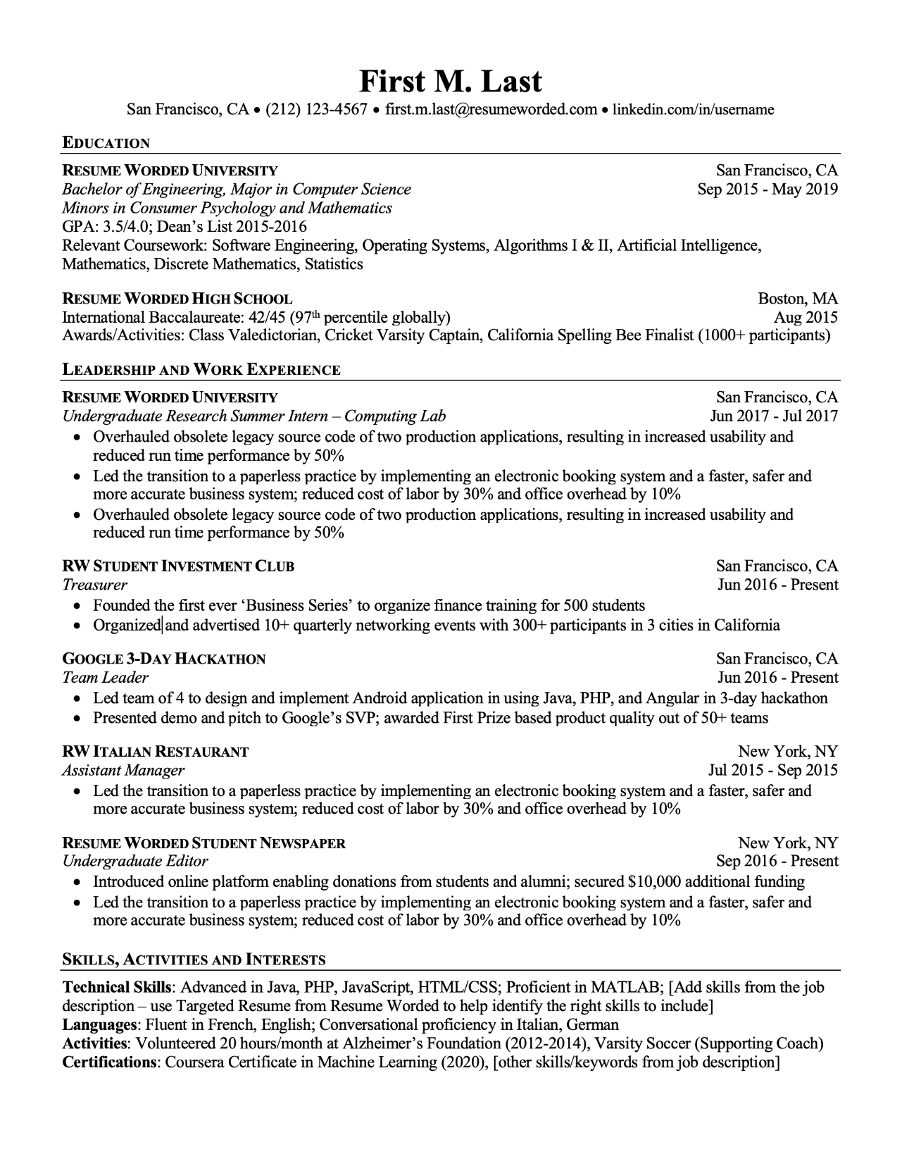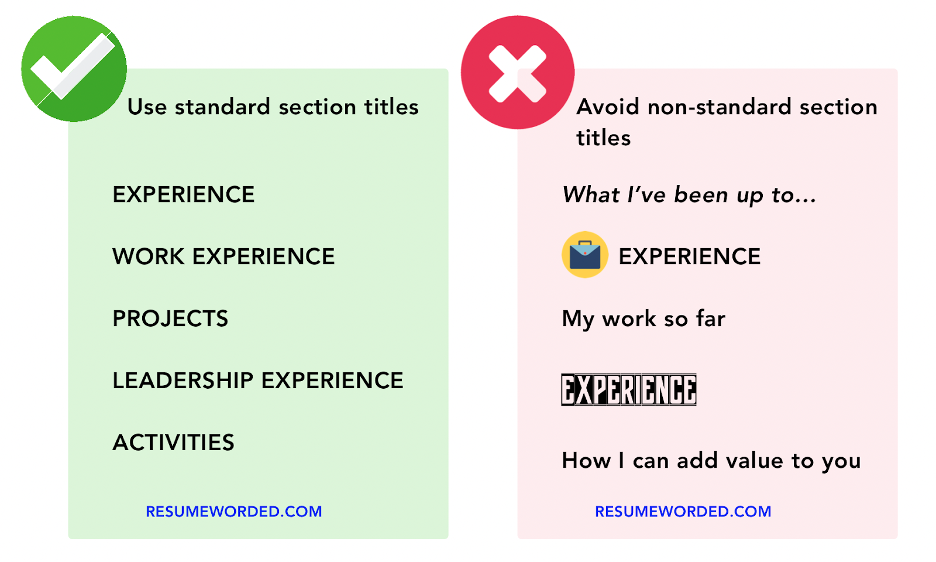Writing a resume can often feel like a balancing act, especially when deciding how much detail to include about each of your previous roles. Your resume doesn’t need to include every job you’ve ever done and should ideally be kept to one page if possible, so you're not alone in wondering how to strike the right balance between being informative and concise.
The ideal number of bullet points per job is typically 4-6, though this will vary based on your overall experience and the role you’re applying for.
In this article, we’ll discuss how many bullet points to include per job depending on your experience level, recent history, and career path. We’ll also discuss how to construct powerful resume bullet points, how to optimize your bullet points for ATS, and other areas of your resume that can be improved using properly formatted bullet points.
How many bullet points per job should you include?
The exact number of bullet points will depend on how recent the position was, how much experience you have overall, and how many relevant accomplishments you have.Here are some general rules to keep in mind:
- Aim for 4-6 bullet points per role.
- You can get away with listing up to 8 bullet points for your most recent role.
- Older positions may only need 1-2 bullet points.
- If you held a job more than 10-15 years ago, leave it off your resume entirely unless it’s specifically relevant.
- If it means keeping your resume under a page or going over, opt for fewer bullet points.
Find out if your resume has the right number of bullet points
An easy way to ensure if you have the right number of resume bullet points — and to check if your resume's bullet points are effective enough — is to upload your resume to Score My Resume for an instant resume review.
You can easily do it below:
The right number of bullet points for different experience levels
The number of bullet points to include per job will change depending on your experience level and the level of the position you’re applying for. For help deciding when and how to use bullet points, use a resume template to show you the optimal location and formatting for resume bullet points.
Entry-level positions
Even if you’re applying to an entry-level position without much (or any) experience, that doesn’t mean you have nothing to include on your resume. Internships, student placements, volunteer work, personal projects, and even coursework and extracurricular activities can all go on your resume in place of paid work experience. Just remember to focus on your accomplishments — no matter how small! Even including 2-3 relevant bullet points can be the key to landing your first position.
For example:
Mid-level positions
If you have some experience in similar roles to the one you’re applying for, you’ll likely use more bullet points to showcase your relevant skills.
Start by brainstorming your most significant accomplishments, then compare these to the job description. Pick 4-6 of the top skills or competencies the hiring manager is looking for, and write your bullet points in a way that demonstrates those.
For example:
Senior or leadership positions
If you’re well-established in your career and applying to more senior roles, it can be tempting to want to exceed the 4-6 bullet point rule. While up to 8 bullet points for your most recent job can be fine, anything more than that will make a recruiter’s eyes glaze over, no matter how impressive your accomplishments are.
Focus on the achievements that speak to your ability to do the job, such as managing a team or department, launching or spearheading new initiatives, and making major improvements to how things are run.
For example:
The right number of bullet points for your career path
Whether you’re changing careers or returning after a recent employment gap, you can use your resume bullet points to highlight transferable skills.
When changing careers
When transitioning to a new industry or role, aim for 4-6 bullet points per position, focusing on those achievements most relevant to the new industry.
Start by identifying skills from your previous roles that are relevant to the new industry, and focus on bullet points that demonstrate these transferable skills. Describe how you applied these skills in tangible ways, quantifying results whenever possible.
For example, if transitioning from a teaching career to corporate training:
- Developed and implemented innovative teaching strategies, increasing student engagement by 30%.
- Led a team of educators in curriculum development, improving standardized test scores by 15%.
After a career break or employment gap
You can use bullet points to positively discuss a career break, gap in your resume, or period of unemployment as you would regular work experience. Include 2-3 bullet points focusing on skills you developed or achievements during this period, such as volunteering, part-time work, freelancing, or personal projects, list them as you would a regular job.
If your break was for personal development, like pursuing further education or professional training, use bullet points to detail what you learned and how it makes you a better candidate. Mention any certifications, courses, or skills acquired, emphasizing how they align with your career goals and the job you’re applying for.
For example:
Freelance and consulting
More than any other type of role, self-employment, freelance and consulting positions can benefit from a short blurb describing what exactly the job entailed. Beyond that, consider breaking up your bullet points into specific projects or clients.
Even though your job may have looked very different to a traditional in-house role, your bullet points should look the same — focus on your accomplishments, use hard numbers to emphasize the impact of your work, and don’t forget to include a conventional company name and job title.
For example:
How to write resume bullet points
Here are the key things to keep in mind when writing your resume bullet points:
- Always use bullet points— not long paragraphs.
- Focus on accomplishments instead of job roles and responsibilities.
- Start your bullet point with a strong action verb.
- Quantify accomplishments with metrics.
- Prioritize bullet points that are relevant to the job you're applying for.
- Use your bullet points to show career progression.
- Optimize your bullet points with essential keywords.
Here is an example of how to construct a powerful resume bullet point:
Bullet points vs. paragraphs
Never list your accomplishments in paragraph format — always use bullet points. If you feel like a particular role needs more context than bullet points can provide, consider including a short 1-2 sentence blurb underneath the job title. You can use this to describe the job or company in more detail or highlight the top skills and accomplishments you want recruiters to focus on.
For example:
Focus on accomplishments
Never list job duties on your resume. Recruiters care about what you achieved, not your assigned responsibilities, so make sure your bullet points don’t read like a job description. Knowing what you’ve achieved in the past gives employers the most insight into what you’re likely to accomplish in this new role.
Use action verbs
Keep your bullet points accomplishment-focused by starting with a strong action verb — your bullet points should be in the format [action verb] + [what you did] + [result]. If you’re struggling to get started, use this bullet point builder to help you create powerful resume bullet points from the ground up.
Include numbers and metrics
You should aim to include some kind of metric with each bullet point. Why? The more concrete and objective the result, the more convincing your accomplishments become. “Increased sales” is vague and unhelpful. “Increased sales by 300%” is specific, impressive, and easier to verify.
Use relevant keywords
In 2024, many companies are using digital screening tools such as Applicant Tracking Systems (ATS) as part of their hiring process. These systems scan and rank resumes based on specific keyword criteria. This reliance on ATS makes it crucial to include relevant skills and keywords for the specific job you’re applying for or risk the automated ATS systems rejecting your resume.
To find essential skills and keywords for your resume that are relevant to the job you’re applying for, use the skills search tool below.
Stick to relevant achievements
Your bullet points should include your most impressive and relevant accomplishments. Increasing sales by 400% via cold calling may be outstanding, but it won’t matter much to a hiring manager if you’re applying for a data entry position. To show your ability to do the job you’re applying for, check the job description and try to match each bullet point with a job duty or key skill mentioned in the ad.
Show career progression
Recruiters want to see career progression, so try not to list the same types of accomplishments for each job. Even if you’ve held a series of jobs mainly doing the same thing, keep your more impressive or higher-level achievements for your recent roles to give a sense of progression.
Remember, your resume should paint a clear picture of what makes you a strong candidate, so choose what to include — or exclude — based on the story you're trying to tell.
Optimize your formatting for ATS
As mentioned above, ATS software is becoming increasingly routine in modern recruitment. Applicant Tracking Systems prioritizes resumes with bullet points that are simply formatted as it can easily pick out the relevant keywords.
To optimize your resume bullet points for ATS, use standard bullets (no fancy images or symbols) and make sure each point is aligned with the job description. You can also build your resume with an ATS-optimized template to ensure ATS compatibility and use our Score My Resume tool to ensure your resume can be read by the AI software.
Where else can you use bullet points?
In addition to your work experience section, you can use bullet points in other areas of your resume, including your resume summary, skills, and education section.
Resume summary bullet points
Resume summaries are optional and should be kept brief — generally no more than 3-5 lines. That said, you can use bullet points to highlight any standout accomplishments or core competencies. For example:
Bullet points in your skills section
If you've opted for a simple skills list at the bottom of your resume, use bullet points to keep this section organized and easily skimmable, as shown in the example below.
Education bullet points
If you're a current student or recent graduate, you can get away with a longer education section at the top of your resume. List any additional information, including relevant coursework, awards, activities, and study abroad, in bullet points underneath the name of your school and degree. For example:
Resume header bullet points
Bullet points are a quick and easy way to keep the information in your resume header neatly separated. This should still fit on one line at the top of your resume, as shown below.
Using bullet points in additional sections
Bullet points are appropriate any time you're listing accomplishments on your resume. That includes sections like volunteer work, projects, activities, and additional information. For example:
Resume bullet points: Do's and Don'ts
To summarize, here are the key points to cover when creating great resume bullet points:
Do:
- Start each bullet point with a strong action verb.
- Quantify your achievements with metrics to provide concrete evidence of your impact.
- Keep each bullet point concise and focused on a single accomplishment or skill.
- Ensure that all achievements listed in your bullet points are accurate and a truthful representation of your skills.
- Use bullet points to reinforce key qualifications mentioned in your cover letter. This creates a cohesive narrative between your resume and cover letter, strengthening your candidacy.
- Tailor your bullet points to align with the job description. Focus on relevant skills and experiences that demonstrate you are a suitable fit for the role without overwhelming the employer with excessive qualifications.
Don't:
- Use vague language that doesn't clearly communicate your role and impact.
- List job duties without context; focus instead on achievements and how you added value.
- Overwhelm the resume with too many bullet points; aim for a balance between detail and brevity.
- Exaggerate or falsify your achievements. This can damage your professional reputation and jeopardize future career opportunities.
- Overemphasize advanced skills or experiences that are not required for the position. This can lead to being screened out for seeming over qualified or might suggest you won't be satisfied with the role's level.
Frequently asked questions
How should you format resume bullet points?
Like any other resume formatting, keep your bullet points simple and easy to read. Stick to standard bullet point symbols. Dashes or automatic bullets are fine, but avoid images or fancy symbols.
Bullet points should always start with a capital letter, but using full stops in your bullets is optional. If your bullet points are full sentences, or if a bullet point includes multiple sentences, you should use a full stop at the end. Whichever you choose, make sure you're consistent throughout your resume.
How long should each bullet point be?
Keep each bullet point to 1-2 lines. Your bullet points should be a concise summary of your resume's accomplishments. If you want to elaborate on a specific achievement, save it for a resume summary, short blurb, or cover letter. Keeping your bullet points concise makes the key parts of your accomplishments stand out.
What if you have more than 4-6 bullet points for a job?
In general, focus on the bullet points per role most relevant to the job you’re applying for. Sometimes, this can mean you’re leaving off some less impressive accomplishments. But by doing this, you're prioritizing the most relevant information and making your resume easily scannable.
That said, if you’ve held multiple roles at the same company — especially if this represents a promotion — you can list each job separately underneath the same company heading. This allows you to list 4-6 bullet points underneath each role, which is a helpful workaround if you’ve spent the bulk of your career at the same employer.
Do you need bullet points for every position?
Generally, every position you list on your resume should have at least 1-2 accomplishment bullet points. That said, you don’t need to list every job you’ve ever held on your resume.
If the job is older (e.g. 10 years or more) but relevant, you can include just the job/role title on your resume with the date (without any bullet points), but if it's a recent position, you should include at least 1-2 bullet points.
When should you leave a role off altogether?
If it’s an older position, a job you only held for a short time, or one that’s not particularly relevant to the job you’re now applying for — in other words, if it’s not going to help you get the job, and taking it off wouldn’t leave a major gap — feel free to leave it off altogether and focus on your more relevant experience.










